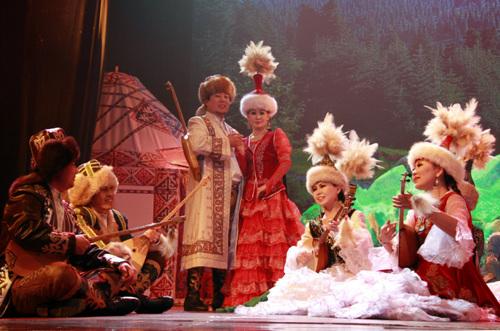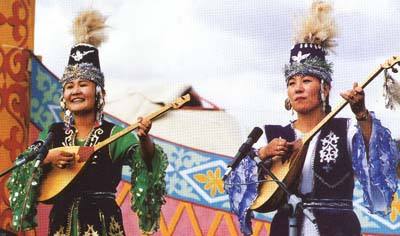Aken ballad singing and playing
4 min readIn ancient times, aites sometimes appeared in large festive gatherings, sometimes on ordinary weddings on which occasions akens looked for rivals, singing in competition andlearned from each other by exchanging experience. The Kazakhs due to the characteristics of nomadic life, have traditionally lived in scattered places, so the singer could only take the opportunity of weddings or other gatherings to ask questions to each other in antiphonal form and improvised answers in the form of poems, through which they imparted knowledge to others or expressed their views. Therefore, this kind of knowledge spreading of the singers can be acclaimed as a mobile school Where there is a party there is the school with an open door and hall to spread knowledge.
Modern and contemporary settlement lifestyle is gradually changing the nomadic lifestyle that has lasted for a thousand years to modern lifestyle. Settlement villages appeared one after another on the grasslands, the cultural ecology including is facing.

new possible transformation Aites that has been passed down orally now has diverse channels of inheritance Education on its heritage has appeared on campus. Currently, Ili Teachers College is trying to cultivate a new generation of akens by organizing “Aken Clas s”Graduated young akens, in addition to the capability to talk with adroit phrase like the old akens, have accepted the influence of modern culture and nourishment. this can be regarded as a new training channel.
Aken ballad singing and playing
Speaking of the origin of aites, it is undoubtedly closely related to the ancient folk songs of the Kazakhs. It has extended the path for folk songs in some sense the tune adopted in aites and folk songs, is not strictly restricted in terms of structure, style, melody beating and content, and has no fixed qupai(names of the tunes to which qu is composed) or corresponding aria. The singers accompany themselves by playing the dombura, or just sing without accompaniment. Every summer, the nomadic herdsmen will come to the fertile summer pastures to hold aken contests with herdsmen from nearby villages Aites was born on the grasslands and is deeply rooted in the Kazakhs on which it has enormous influence. The words of aites songs are all improvised instead of being fixed. So akens must be witty and have a considerable knowledge and capability to talk adroit with phrases and ability to understand and a high artistic accomplishment which enable them to give persuasive and reasonable answers instantly.

It is well-known that in the history of human civilization there are many important oral historical works, for instance the narrative long poems Iliad and odyssey, both of which are acclaimed as the “Bible of Greece”, the epic gilgamesh of the Sumerian, the narrative long poems in Sanskrit scripts Mahabharata and Ramayana of the Indians the narrative longpoem Jangar of the Mongolians, the narrative long poem Manas of the Khalkhas and the narrative long poems Hero targen and Hobrand of the Kazakhs. Oral inheritance is still a tradition full of vitality and life. Various narrative forms and types are adopted in retelling ancient stories, sharing personal experience, transmitting objective knowledge and judgingright and wrong. Oral spreading offers an effective way to share people’s daily experience and knowledge, telling local historical events, legends, expressing humorous wisdom, making moral judgment and conveying artistic taste. the descendants of the nomadic people not only get to know the significance of these works, but also draw nutrition from them and regard them as the best works which bond them together Aites that has developed in oral form is by no means inferior to any of these works; instead, it is like the glittering stars in the sky, casting beautiful reflections on each other Since ancient times grassland ethnic groups have been living on the grasslands where there are water and grass. The space on the grasslands is always moving. The life under every tent changes between the grasslands and mountains, which has resulted in a pure and strong inner world of the Kazakhs. Poems and horses are the two wings of the Kazakhs This vividly shows the nature of grassland culture. In contrast, farming ethnic groups tend to narrate rather than create, focusing on materials collection and recording. The Han people show the entire humanity the significance and necessity of the memory of farming civilization times by written materials, as represented by the Twenty-four Histories. As anomadic people, the Kazakhs clearly convey the nomadic civilization by aites, interpretingnomadic grassland culture in a different way. This is living oral and original memory. Thegrassland culture arising from nomadic way of life is always rough and strong and not lack of persistence and vividness. Like numerous nomadic ethnic groups, the Kazakhs have already been proved by history its depth and accumulation of culture. Aites as the cultural memory of generations of the Kazakhs make it possible for an ancient ethnic group to show vividly its national gene and charm of nomadic culture today.








